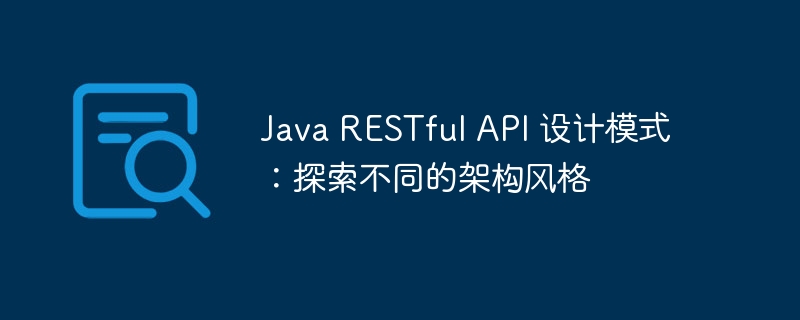Java RESTful API 設計模式:探索不同的架構風格

Java RESTful API 設計模式是現代軟體開發中至關重要的一環。在這篇文章中,php小編草莓將帶領大家探索不同的架構風格,深入了解RESTful API設計的關鍵概念與最佳實務。無論您是初學者還是經驗豐富的開發人員,本文都將為您揭示如何透過合理的設計模式來建立高效、可維護的RESTful API,為您的專案增添更多優勢。
1. RESTful 資源
RESTful 資源是 API 的核心組成部分。它們表示應用程式中感興趣的實體,例如客戶、產品或訂單。資源使用 URI 標識,並且可以透過 Http 方法(GET、POST、PUT、DELETE)進行操作。
@Entity
public class Customer {
@Id
@GeneratedValue(strategy=GenerationType.AUTO)
private Long id;
private String name;
private String email;
// ...
}2. 超媒體
#超媒體 API 提供額外的信息,例如可用操作的連結、格式規格和相關的資源。這使得客戶端能夠動態地瀏覽和互動 API,而無需事先了解其所有端點。
@GetMapping(produces = {MediaType.APPLICATION_HAL_JSON_VALUE})
public ResponseEntity<Resource<Customer>> getCustomer(@PathVariable Long id) {
Customer customer = customerService.findById(id);
Resource<Customer> resource = new Resource<>(customer);
resource.add(linkTo(methodOn(CustomerController.class).getCustomer(id)).withSelfRel());
resource.add(linkTo(methodOn(CustomerController.class).getAllCustomers()).withRel("customers"));
return ResponseEntity.ok(resource);
}3. HATEOAS
HATEOAS(超文本作為應用程式狀態引擎)是一種 RESTful 架構模式,它使用超媒體讓客戶端了解可用操作和資源。透過將狀態嵌入到 API 回應中,HATEOAS 消除了對文件的需要,並促進了 API 的可發現性。
@GetMapping(produces = {MediaType.APPLICATION_HAL_jsON_VALUE})
public ResponseEntity<Resource<Customer>> getCustomer(@PathVariable Long id) {
Customer customer = customerService.findById(id);
Resource<Customer> resource = new Resource<>(customer);
resource.add(linkTo(methodOn(CustomerController.class).getCustomer(id)).withSelfRel());
resource.add(linkTo(methodOn(CustomerController.class).getAllCustomers()).withRel("customers"));
resource.add(linkTo(methodOn(CustomerController.class).updateCustomer(id, null)).withRel("update"));
resource.add(linkTo(methodOn(CustomerController.class).deleteCustomer(id)).withRel("delete"));
return ResponseEntity.ok(resource);
}4. 微服務
#微服務是一種架構風格,其中應用程式被分解為鬆散耦合的小服務。每個微服務負責一個特定功能,並透過 API 與其他服務進行通訊。這種模式提高了可擴充性、靈活性,並且還簡化了維護和部署。
@SpringBootApplication
public class CustomerMicroserviceApplication {
public static void main(String[] args) {
springApplication.run(CustomerMicroserviceApplication.class, args);
}
}
@RestController
@RequestMapping("/api/customers")
public class CustomerController {
@Autowired
private CustomerService customerService;
@GetMapping
public List<Customer> getAllCustomers() {
return customerService.findAll();
}
@GetMapping("/{id}")
public Customer getCustomer(@PathVariable Long id) {
return customerService.findById(id);
}
@PostMapping
public Customer createCustomer(@RequestBody Customer customer) {
return customerService.save(customer);
}
@PutMapping("/{id}")
public Customer updateCustomer(@PathVariable Long id, @RequestBody Customer customer) {
return customerService.update(id, customer);
}
@DeleteMapping("/{id}")
public void deleteCustomer(@PathVariable Long id) {
customerService.delete(id);
}
}選擇最佳模式
#選擇合適的 RESTful API 設計模式取決於應用程式的特定要求。對於簡單且靜態的 API,RESTful 資源模型就足夠了。對於更複雜的 API,超媒體或 HATEOAS 可以提供更好的可發現性。微服務模式適用於需要可擴充性和靈活性的大型應用程式。
結論
RESTful API 的設計模式提供了指導,幫助開發人員創建高效、可維護且可擴展的 API。透過了解不同的架構風格,您可以選擇最適合您應用程式需求的模式,從而實現更好的 API 設計和互動。
以上是Java RESTful API 設計模式:探索不同的架構風格的詳細內容。更多資訊請關注PHP中文網其他相關文章!

熱AI工具

Undresser.AI Undress
人工智慧驅動的應用程序,用於創建逼真的裸體照片

AI Clothes Remover
用於從照片中去除衣服的線上人工智慧工具。

Undress AI Tool
免費脫衣圖片

Clothoff.io
AI脫衣器

Video Face Swap
使用我們完全免費的人工智慧換臉工具,輕鬆在任何影片中換臉!

熱門文章

熱工具

記事本++7.3.1
好用且免費的程式碼編輯器

SublimeText3漢化版
中文版,非常好用

禪工作室 13.0.1
強大的PHP整合開發環境

Dreamweaver CS6
視覺化網頁開發工具

SublimeText3 Mac版
神級程式碼編輯軟體(SublimeText3)
 PHP框架與微服務:雲端原生部署與容器化
Jun 04, 2024 pm 12:48 PM
PHP框架與微服務:雲端原生部署與容器化
Jun 04, 2024 pm 12:48 PM
PHP框架與微服務結合的好處:可擴展性:輕鬆擴展應用程序,添加新功能或處理更多負載。靈活性:微服務獨立部署和維護,更容易進行更改和更新。高可用性:一個微服務的故障不會影響其他部分,確保更高可用性。實戰案例:使用Laravel和Kubernetes部署微服務步驟:建立Laravel專案。定義微服務控制器。建立Dockerfile。建立Kubernetes清單。部署微服務。測試微服務。
 Java 框架如何支援微服務的橫向擴展?
Jun 04, 2024 pm 04:34 PM
Java 框架如何支援微服務的橫向擴展?
Jun 04, 2024 pm 04:34 PM
Java框架支援微服務的橫向擴展,具體方式包括:SpringCloud提供Ribbon和Feign用於伺服器端和客戶端負載平衡。 NetflixOSS提供Eureka和Zuul,實現服務發現、負載平衡和故障轉移。 Kubernetes透過自動擴展、健康檢查和自動重新啟動簡化了橫向擴展。
 Spring Boot 在微服務架構中扮演什麼角色?
Jun 04, 2024 pm 02:34 PM
Spring Boot 在微服務架構中扮演什麼角色?
Jun 04, 2024 pm 02:34 PM
SpringBoot在微服務架構中扮演著簡化開發和部署的至關重要角色:提供基於註解的自動配置,處理常見配置任務,如資料庫連接。透過契約測試支援驗證API合約,減少服務之間的破壞性變更。具有生產就緒性功能,如度量收集、監視和健康檢查,便於在生產環境中管理微服務。
 使用 Golang 微服務框架建立分散式系統
Jun 05, 2024 pm 06:36 PM
使用 Golang 微服務框架建立分散式系統
Jun 05, 2024 pm 06:36 PM
使用Golang微服務框架建立分散式系統:安裝Golang、選擇微服務框架(如Gin)建立Gin微服務,新增端點部署微服務,建置並執行應用程式建立訂單和庫存微服務,使用端點處理訂單和庫存使用Kafka等訊息傳遞系統連接微服務使用sarama庫生產和消費訂單訊息
 PHP框架與微服務:資料一致性與交易管理
Jun 02, 2024 pm 04:59 PM
PHP框架與微服務:資料一致性與交易管理
Jun 02, 2024 pm 04:59 PM
在PHP微服務架構中,資料一致性和事務管理至關重要。 PHP框架提供機制來實作這些需求:使用事務類,如Laravel中的DB::transaction,來定義事務邊界。使用ORM框架,如Doctrine,提供原子操作,如lock()方法,防止並發錯誤。對於分散式事務,考慮使用Saga或2PC等分散式事務管理器。例如,在線上商店場景中使用事務,在新增至購物車時確保資料一致性。透過這些機制,PHP框架有效管理事務和資料一致性,提高應用程式健全性。
 採用 Java 框架建構微服務架構面臨的挑戰?
Jun 02, 2024 pm 03:22 PM
採用 Java 框架建構微服務架構面臨的挑戰?
Jun 02, 2024 pm 03:22 PM
採用Java框架建構微服務架構涉及以下挑戰:服務間通訊:選擇合適的通訊機制,如RESTAPI、HTTP、gRPC或訊息佇列。分散式資料管理:維護資料一致性和避免分散式事務。服務發現與註冊:整合SpringCloudEureka或HashiCorpConsul等機制。配置管理:使用SpringCloudConfigServer或HashiCorpVault集中管理配置。監控和可觀察性:整合Prometheus和Grafana進行指標監控,同時使用SpringBootActuator提供操作指標。
 PHP設計模式:測試驅動開發實踐
Jun 03, 2024 pm 02:14 PM
PHP設計模式:測試驅動開發實踐
Jun 03, 2024 pm 02:14 PM
TDD用於編寫高品質PHP程式碼,步驟包括:編寫測試案例,描述預期功能並使其失敗。編寫程式碼,僅使測試案例通過,無需過度優化或詳細設計。測試案例通過後,優化和重構程式碼以提高可讀性、可維護性和可擴展性。
 Guice框架中設計模式的應用
Jun 02, 2024 pm 10:49 PM
Guice框架中設計模式的應用
Jun 02, 2024 pm 10:49 PM
Guice框架應用了多項設計模式,包括:單例模式:透過@Singleton註解確保類別只有一個實例。工廠方法模式:透過@Provides註解建立工廠方法,在依賴注入時取得物件實例。策略模式:將演算法封裝成不同策略類,透過@Named註解指定具體策略。






